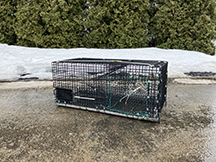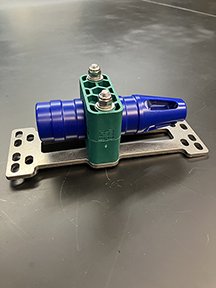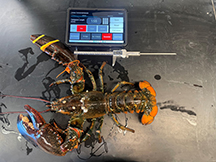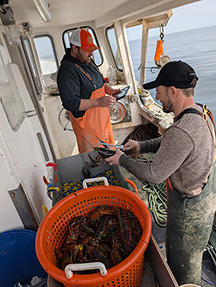Study Goal
The Fisheries Direct Data Program was created in 2024 in response to requests from industry for more data on lobsters in offshore areas than is gathered by the existing Lobster Sea Sampling Program, and for more data on juvenile lobsters in deeper water than is provided by the Ventless Trap Survey.
To collect this data, the Maine Department of Marine Resources (DMR) has partnered with the Commercial Fisheries Research Foundation (CFRF) with funding from the Maine Lobster Research Education and Development Board to train lobstermen to collect catch, effort and biological information on their kept and discarded lobsters and Jonah crabs. This program will focus on lobstermen who fish year-round in federal waters and fish in areas where the Lobster Sea Sampling Program has historically collected less data. The data collected through this program will allow Maine DMR to gain a more complete picture of the portion of the lobster population that is targeted by lobstermen fishing offshore.
Project Objectives
- Collect more catch, effort, and biological data in all zones and seasons for areas that are less consistently sampled by other surveys.
- Investigate the size frequency distribution of lobsters living in deeper waters.
- Allow industry members to collect data in areas they believe are most relevant to the offshore lobster population.
- Improve relationships between Maine DMR and industry through direct survey participation.
- Engage industry members, DMR scientists, and CFRF, a non-profit research foundation, in a collaborative research project.
Study Design
Starting in 2025, DMR will work with ten lobstermen in year one and an additional ten lobstermen in year two to train a total of twenty lobstermen to collect data on Maine’s offshore lobster population. These lobstermen will be spread evenly between Maine’s Lobster Management Zones (A-G).
In collaboration with CFRF, DMR will provide each lobsterman with equipment used to measure, record, and upload catch, effort, and biological information on lobsters and Jonah crabs. Each lobsterman will also receive 3 ventless traps to add to trawls located in Federal waters to collect additional information on the juvenile lobsters that may escape from standard commercial fishing gear. A temperature and depth sensor (Moana TD Sensor) will also be given to each lobsterman to be placed inside one ventless trap of their choice.




Lobstermen will sample both their ventless traps and a portion of their commercial gear for lobsters and Jonah crabs via multiple sampling sessions throughout each month. Effort and Biological data will be collected in the On Deck Data app co-created by CFRF. Effort data will include gear characteristics and trip information while biological data will include:
- Carapace Length
- Sex
- Shell hardness
- Shell disease presence and severity
- Egg presence and stage (for females)
- V-notch presence (for females)
- Kept/discard status
They will also collect bottom temperature data and water column temperature profiles using the Moana TD Sensor located in one of their ventless traps. Lobstermen who participate in the program are compensated for their sampling efforts on a per-session basis.
Data collected from the Fisheries Direct Data Pilot Program will be used to gain a more complete understanding of the dynamics of the offshore lobster population in all zones and seasons as well as to further investigate the size frequency distribution of lobsters living in deeper water. DMR will also use this project to assess whether a more permanent expansion of lobster sampling efforts into federal waters in the Gulf of Maine is necessary.
Contacts
Peter Jordan, Fisheries Direct Data Project Lead
Anna Dorrance, Fisheries Direct Data Project Supervisor